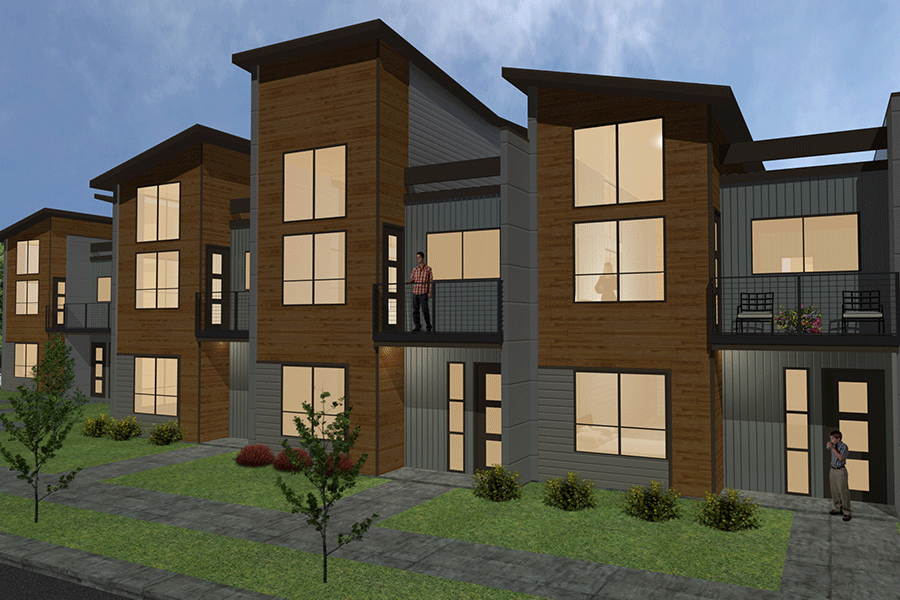The city of Whitefish recently made strides in its goal to build out the local inventory of affordable workforce housing, a scarcity of which has priced out middle-income, working-class residents, leaving them with limited options when it comes to finding comfortable, cost-effective living arrangements.
On April 2, city council voted unanimously to approve a zone change for the city’s snow lot near the corner of Columbia Avenue and Railway Street. Changing the land-use map from industrial to accommodate multi-family homes moves the city closer toward developing workforce housing on the plot. The Whitefish Strategic Housing Plan identifies development of the 1.64-acre parcel into workforce housing units as a top strategic priority.
Still, development of the property is likely years down the road, and neighbors have raised concerns about whether affordable housing in a unique and historic neighborhood will mesh with its character, while parking is already a troublesome problem.
Council was sympathetic to those concerns, but said the community is out of options.
“I understand that this is very scary to the neighbors,” Whitefish City Councilor Katie Williams said during the meeting. “You don’t know exactly what is going to be developed. But it’s imperative that we have community buy-in. I think it will be something that, 20 years down the road, we will look at this and say ‘OK, we actually did something right.’ We don’t want to slap up a bunch of apartments and flood the streets with parking. We want something that blends in with the community.”
Last November, city leaders adopted a blueprint to guide the community as it grapples with an affordable housing crisis as residents grapple with a scarce rental inventory, while homeownership remains out of reach for young professionals looking to enter an outsized market that towers above the average household income.
In January, council voted to approve amending the downtown master plan to show the future land use of the snow lot as designated for multi-family residential housing rather than parking. The land use designation change allows the city to include the property as part of the tax increment finance boundary and therefore allow TIF dollars to be spent on items like soil testing to aide in decisions about how the lot might be developed.
“The reason I am in favor of this is that we are just plain out of options,” Councilor Richard Hildner said. “Until we get a rezone we can’t even begin to discuss other options for this property. I don’t think full development of an industrial site would be anymore pleasing to you in the neighborhood than affordable housing.”
Lori Collins, executive director of the Whitefish Housing Authority, said her board is actively working to create affordable, mixed-use, mixed-income housing on the property. Collins said she understands that the term “affordable housing” makes neighbors nervous, and that the snow lot site will serve as a model example.
“This will be our shining model of what we are capable of accomplishing,” Collins said. “This will be our big shot out of the gate to prove that we are not building stack-‘em-up tenement houses. It’s housing for regular people. We are going to build houses that people like us want to live in.”
Meanwhile, work is set to begin on the new Alta Views housing project off JP Road, where the Whitefish Housing Authority has been allotted 10 new townhomes as part of the city’s voluntary inclusionary zoning, Collins said. The units are to be built as part of an expansion of 29 existing condos at Deer Creek and The Views. The condos were built in 2007, but development of the subdivision came to a halt when the recession hit.
Whitefish-based developer Mark Panissidi has received the city’s approval to develop a 166-lot subdivision that will accommodate 137 new townhomes. While only 10 of those units are set aside as affordable housing, a starting price of $289,000 for a two-bedroom, two-bath townhome with a two-car garage is “not bad for Whitefish,” Collins said.
“It is not affordable to everybody, but it is affordable to some,” she said. “This is a nice drop in a big bucket.”
In seeking approval of the project, Panissidi, of Del Mar Pacific Group LLC, worked to reconfigure the lots to offer housing within reach to working-class families, offering townhomes instead of condominiums.
Ken Huff, the project’s architect, said the property has languished for more than a decade. Focusing the development on townhomes instead of condos means buyers can more easily qualify for financing.
“There is just no reason this property should have sat vacant for 10 years, but financing is so difficult for condos,” Huff said. “If we were building condos, you have to be walking in with eighty-thousand-dollars just to make a down payment. It was just a different economy back then. Today, there aren’t 130 people walking around with one-hundred-grand in their pockets. But there are people who can afford three or five percent.”
Collins said housing is typically defined as affordable when a household is spending 30 percent of its income on housing and utilities.
“If you’re spending more than 40 percent, it becomes onerous,” she said.
But for plenty of Whitefish residents, that’s their reality.
“We need housing for real people that have real jobs that live in this town,” Collins said, “They’re not poor. They are working people who need a home.”
